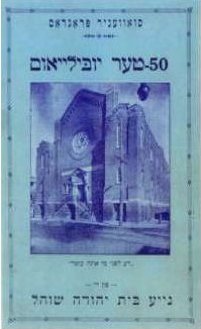T

he
50th anniversary booklet of 1940 suggests that the congregation
recognized its date of origin as being around 1890. The booklet
features a history of the congregation written by a former president,
Gidaliahu Michalovksy, based on "archives of the synagogue
recollections of older members and activists." According
to his account, the Beth Yehuda originated with a small congregation
of Hasidic followers of the Bohusher rabbi. They named the congregation
Ohel Moshe after the Bohusher rabbi's son. The congregation took
on the name Beth Yehuda with the purchase of a former theatre
creating "quite a fine shul" which allowed the congregation
to attract more members making it, by their own account, a focal
point of the community. Even in this renovated building, their
records indicated a constant struggle to maintain the building.
Nevertheless, an offer to purchase the building in 1914, prompted
them to consider purchasing a lot further north in order to construct
a new synagogue.
The completion of the synagogue on Duluth and Hotel de Ville in
1923 was naturally a momentous and proud moment for the congregation.
"In that year the large and beautiful synagogue was built
with all the improvements and with splendor and glory. Neither
effort nor money was spared. We erected such a fine building that
it was the pride of all Montreal Jews."
This moment of pride was soon to be deflated. Reflective of the
financial difficulties which were to continue to plague the congregation,
no sooner was it erected, than it was placed on a "sheriff's
sale," due to unpaid bills to contractors, and rescued, thanks
to the intervention of several generous members, a situation which
reoccurred with alarming frequency. The congregation, burdened
by an expensive building, was vulnerable not only to economic
fluctuations, but to the constantly changing residential patterns
of its members. When Mr. Michalovsky took office in 1929 he noted
that even more serious than the stock market crash was the movement
away from the neighborhood of the wealthier members and seat holders
who left the synagogue a "widow" with deficits, debts,
and expenses.
The need to raise funds was an ongoing enterprise. One of the
more successful fundraising strategies was the presentation of
cantorial concerts. Well known cantors, often from the States,
were invited to serve during the High Holidays. Often a concert
would be presented before the holidays which would not only bring
in revenue but encourage the purchase of seats. The performances
of one rather young cantor proved to be particularly successful.
Following a warning of a bank foreclosure in 1934, Mr. Michalovsky
suggested that a cantor be hired for Saturdays and special concerts.
When the first two cantors proved to be a disappointing draw,
it was decided to bring in Cantor Shloimele, an eleven year old
prodigy. The young cantor was engaged to sing for the High Holidays.
"It was an event that brought a smile to the face of every
member." The enterprise with Cantor Shloimele brought in
a profit of $4,000, four times the amount that had been raised
in their previously most successful concert!